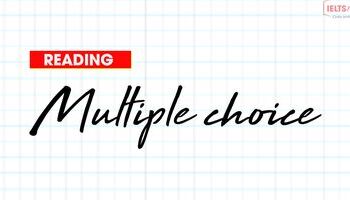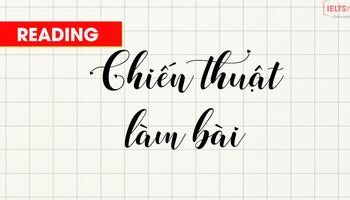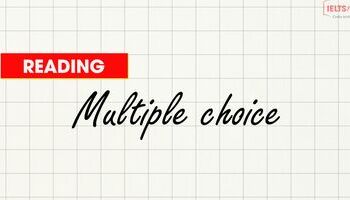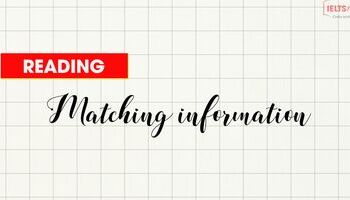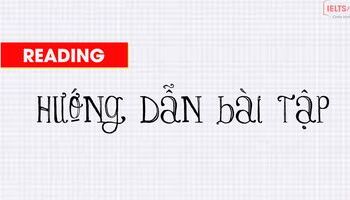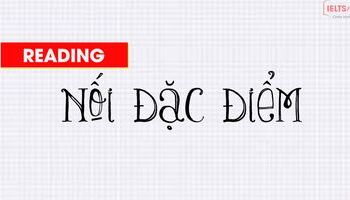Bước vào bài học hôm nay, chúng ta cùng tìm hiểu dạng bài Multiple Choice - một dạng bài khá là nhiều bẫy trong IELTS Reading nha.
1. Multiple Choice là gì?
Đây là dạng mình sợ nhất trong bài thi Reading, chắc có lẽ vì hồi trước mình hay sai dạng này nhất, nhưng giờ đỡ nhiều rồi hehe. Dạng này là những câu hỏi trắc nghiệm 4 đáp án, nhiệm vụ của bạn là đọc và chọn 1 đáp án đúng. Đơn giản đúng không, nhưng cực kỳ dễ sai và dễ nhầm lẫn nhé!
Dạng bài này trong Listening cũng khó, trong Reading cũng không hề dễ, vì các đáp án nhìn chung khá dài, đặc biệt trong Reading, 4 đáp án hoàn toàn khác nhau, chứ hầu như mình thấy không có kiểu “tìm ra điểm khác nhau giữa 4 đáp án” rõ ràng như trong Listening.
Cách làm bài mình sẽ nói bên dưới, các bạn nhìn sơ qua dạng bài nhé!
2. Cách làm bài Multiple Choice
Bước 1: Đọc kỹ câu hỏi và đọc lướt 4 đáp án
Với dạng Multiple Choice, chắc chắn câu hỏi sẽ sẽ sắp xếp theo thứ tự. Nên chiến lược của mình là đọc câu đầu tiên trước, chứ không đọc 1 loạt tất cả các để tìm keywords rồi cố gắng nhớ. Mình đọc câu đầu tiên, xem nội dung người ta hỏi về cái gì, và đọc câu hỏi thôi, còn đáp án xem lướt qua, rồi tìm xem nội dung đó nằm ở đâu trong bài đọc.
Bước 2: Scanning Thông tin trong bài đọc
Sau khi biết được vị trí rồi, mình sẽ đọc các thông tin trong đoạn đó, thường là đoạn ngắn hoặc 3-4 câu xung quanh. Rồi lật qua đọc lại tất cả các đáp án.
Lúc này, mình sẽ dùng phương pháp loại trừ đáp án sai. Thường mình thấy sẽ có 2 đáp án không liên quan (100% không được nhắc đến trong bài đọc), thì loại 2 đáp án đó trước. Còn 2 đáp án sẽ na ná nhau hoặc có chứa thông tin được nhắc đến trong bài đọc. Lúc này mình sẽ đọc thật kỹ 2 đáp án đó và đối chiếu với thông tin trong bài đọc, nếu trùng khớp thì chọn. Còn không đề cập (Not given) thì loại luôn.
Mình thấy dùng phương pháp loại trừ khá là nhanh và độ chính xác cao.
Bước 3: Check đáp án
Cái này mình không chắc sẽ đúng 100% nhưng các bạn cứ thử check xem sao ha, ví dụ như là từ câu 21 – 26 là Multiple Choice.
21B, 22B, 23B, 24C, 25A, 26D. Thì các bạn thấy 3 câu B liên tiếp, nên check lại 1 trong 3 câu đó. Tuy nhiên không hẳn nha, nếu các bạn chắc chắn 3 câu đó là B thì để nguyên không cần sửa. Vì đáp án đôi khi cũng có 3 câu B liên tiếp, chẳng sao cả. Nhưng cứ chắc ăn thì check lại ha!
Còn khi nào 1 loạt 5-6 câu đều B hết thì hơn 90% là sai sai rồi đó.
3. Ví dụ làm bài Multiple Choice
Riêng dạng này mình sẽ đặc biệt bonus cho các bạn 1 ví dụ để có thể hiểu kỹ hơn về cách làm bài nhé!
Trong Cam 15 có một câu như sau:
Why does Tehrani refer to Chinese and Japanese fairy tales?
A. to indicate that Jack Zipes’ theory is incorrect.
B. to suggest that crime is a global problem.
C. to imply that all fairy tales have a similar meaning.
D. to add more evidence for Jack Zipe’s ideas.
+ Bước 1: Đọc câu hỏi Chú ý “Chinese and Japanese”
Đọc lướt câu trả lời Chú ý “Jack Zipes”
+ Bước 2: Nhớ 2 keywords này, tìm vị trí trong bài đọc
Đoạn kế cuối:
Jack Zipes at the University of Minnesota, Minneapolis, is unconvinced by Tehrani’s views on fairy tales. ‘Even if they’re gruesome, they won’t stick unless they matter,’ he says. He believes the perennial theme of women as victims in stories like Little Red Riding Hood explains why they continue to feel relevant. But Tehrani points out that although this is often the case in Western versions, it is not always true elsewhere. In Chinese and Japanese versions, often known as The Tiger Grandmother, the villain is a woman, and in both Iran and Nigeria, the victim is a boy.
+ Bước 3:
Đọc lại câu hỏi “Tại sao Tehrani nhắc đến chuyện cổ tích Trung Quốc và Nhật Bản?”
Đọc nội dung đoạn trên và nắm ý “Ông Jack Zipes cho rằng chuyện Cô bé quàng khăn đỏ thì phụ nữ là nạn nhân trong câu chuyện nên họ cảm thấy có liên kết hơn. Nhưng Tehrani chỉ ra rằng mặc dù đó là những gì thường thấy trong những câu chuyện ở Phương Tây, nhưng không hẳn là đúng ở những nơi khác. Ví dụ như trong chuyện cổ tích Trung Quốc và Nhật Bản thì phân vật phản diện là phụ nữ, hay ở Iran và Nigeria thì nạn nhân là một cậu bé.”
+ Bước 4:
Đọc đáp án:
B. crime is a global problem. Không liên quan Loại
C. to imply that all fairy tales have a similar meaning. Không liên quan Loại
Còn lại:
A. to indicate that Jack Zipes’ theory is incorrect. (để chỉ ra rằng giả thuyết của Jack Zipes là sai)
D. to add more evidence for Jack Zipe’s ideas. (để thêm minh chứng cho ý tưởng của Jack Zipes)
Trong bài đọc bạn thấy Tehrani có nói “But Tehrani points out that it is not always true” Tức là đang phản biện lại Jack Loại D Chọn đáp án A
4. Luyện tập
You should spend about 20 minutes on Questions 1–13, which are based on Reading Passage 1 below.
MAKING TIME FOR SCIENCE
Chronobiology might sound a little futuristic – like something from a science fiction novel, perhaps – but it’s actually a field of study that concerns one of the oldest processes life on this planet has ever known: short-term rhythms of time and their effect on flora and fauna.
This can take many forms. Marine life, for example, is influenced by tidal patterns. Animals tend to be active or inactive depending on the position of the sun or moon. Numerous creatures, humans included, are largely diurnal – that is, they like to come out during the hours of sunlight. Nocturnal animals, such as bats and possums, prefer to forage by night. A third group are known as crepuscular: they thrive in the low-light of dawn and dusk and remain inactive at other hours.
When it comes to humans, chronobiologists are interested in what is known as the circadian rhythm. This is the complete cycle our bodies are naturally geared to undergo within the passage of a twenty-four hour day. Aside from sleeping at night and waking during the day, each cycle involves many other factors such as changes in blood pressure and body temperature.
Not everyone has an identical circadian rhythm. ‘Night people’, for example, often describe how they find it very hard to operate during the morning, but become alert and focused by evening. This is a benign variation within circadian rhythms known as a chronotype.
Scientists have limited abilities to create durable modifications of chronobiological demands. Recent therapeutic developments for humans such as artificial light machines and melatonin administration can reset our circadian rhythms, for example, but our bodies can tell the difference and health suffers when we breach these natural rhythms for extended periods of time. Plants appear no more malleable in this respect; studies demonstrate that vegetables grown in season and ripened on the tree are far higher in essential nutrients than those grown in greenhouses and ripened by laser.
Knowledge of chronobiological patterns can have many pragmatic implications for our day-to-day lives. While contemporary living can sometimes appear to subjugate biology – after all, who needs circadian rhythms when we have caffeine pills, energy drinks, shift work and cities that never sleep? – keeping in synch with our body clock is important.
The average urban resident, for example, rouses at the eye-blearing time of 6.04 a.m., which researchers believe to be far too early. One study found that even rising at 7.00 a.m. has deleterious effects on health unless exercise is performed for 30 minutes afterward. The optimum moment has been whittled down to 7.22 a.m.; muscle aches, headaches and moodiness were reported to be lowest by participants in the study who awoke then.
Once you’re up and ready to go, what then? If you’re trying to shed some extra pounds, dieticians are adamant: never skip breakfast. This disorients your circadian rhythm and puts your body in starvation mode. The recommended course of action is to follow an intense workout with a carbohydrate-rich breakfast; the other way round and weight loss results are not as pronounced.
Morning is also great for breaking out the vitamins. Supplement absorption by the body is not temporal-dependent, but naturopath Pam Stone notes that the extra boost at breakfast helps us get energised for the day ahead. For improved absorption, Stone suggests pairing supplements with a food in which they are soluble and steering clear of caffeinated beverages. Finally, Stone warns to take care with storage; high potency is best for absorption, and warmth and humidity are known to deplete the potency of a supplement.
After-dinner espressos are becoming more of a tradition – we have the Italians to thank for that – but to prepare for a good night’s sleep we are better off putting the brakes on caffeine consumption as early as 3 p.m. With a seven hour half-life, a cup of coffee containing 90 mg of caffeine taken at this hour could still leave 45 mg of caffeine in your nervous system at ten o’clock that evening. It is essential that, by the time you are ready to sleep, your body is rid of all traces.
Evenings are important for winding down before sleep; however, dietician Geraldine Georgeou warns that an after-five carbohydrate-fast is more cultural myth than chronobiological demand. This will deprive your body of vital energy needs. Overloading your gut could lead to indigestion, though. Our digestive tracts do not shut down for the night entirely, but their work slows to a crawl as our bodies prepare for sleep. Consuming a modest snack should be entirely sufficient.
© The British Council 2012. All rights reserved. 3
Questions 8–13
Choose the correct letter, A, B, C or D.
Write the correct letter in boxes 8–13 on your answer sheet.
8 What did researchers identify as the ideal time to wake up in the morning?
A 6.04
B 7.00
C 7.22
D 7.30
9 In order to lose weight, we should
A avoid eating breakfast
B eat a low carbohydrate breakfast
C exercise before breakfast
D exercise after breakfast
10 Which is NOT mentioned as a way to improve supplement absorption?
A avoiding drinks containing caffeine while taking supplements
B taking supplements at breakfast
C taking supplements with foods that can dissolve them
D storing supplements in a cool, dry environment
11 The best time to stop drinking coffee is
A mid-afternoon
B 10 p.m.
C only when feeling anxious
D after dinner
12 In the evening, we should
A stay away from carbohydrates
B stop exercising
C eat as much as possible
D eat a light meal
13 Which of the following phrases best describes the main aim of Reading Passage 1?
A to suggest healthier ways of eating, sleeping and exercising
B to describe how modern life has made chronobiology largely irrelevant
C to introduce chronobiology and describe some practical applications
D to plan a daily schedule that can alter our natural chronobiological rhythms
KEY ANSWER
8 C
9 C
10 B
11 A
12 D
13 C
Link tải bản PDF nhé:
| Multiple Choice |
Lộ trình Khóa học được dẫn dắt bởi Ms.Jenny trong group IELTS Fighter - Hỗ trợ học tập nha các bạn. Nhớ theo dõi bài học thường xuyên cùng các bạn trong group nhé.
Xem thêm bài học cùng lộ trình:
Sharpen your IELTS Reading Skill - TRUE/FALSE/NOT GIVEN
Sharpen your IELTS Reading Skill - SHORT ANSWER
